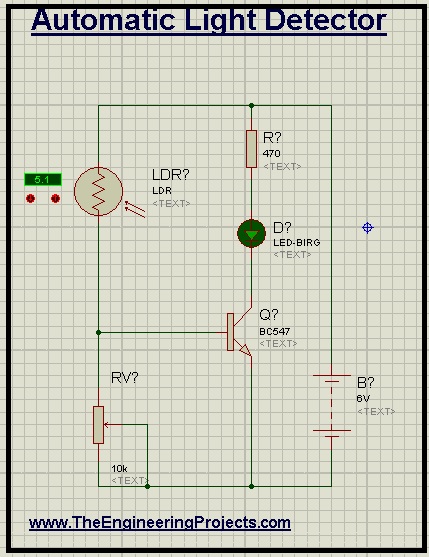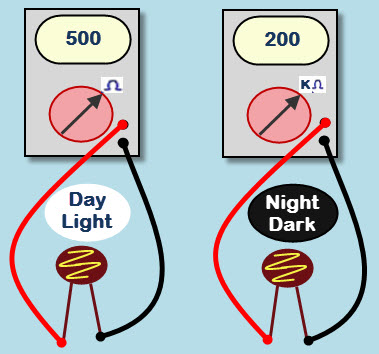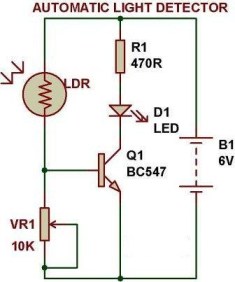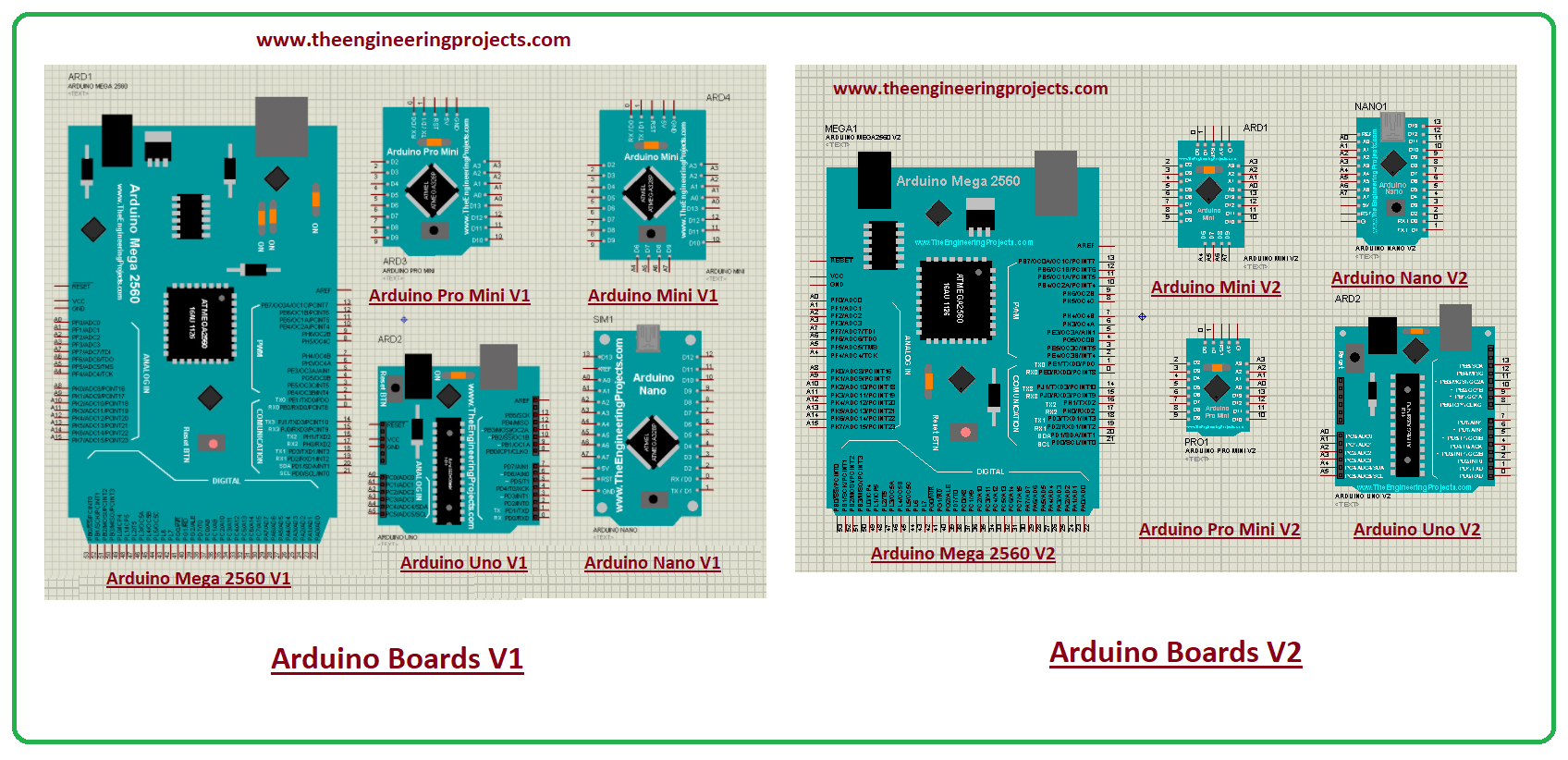

Automatic Light Detector using LDR in Proteus


- What is Automatic Light Detector?
- What are different components and their functions in the Automatic Light Detector?
- How does the circuit of Automatic Light Detector works?
- How can we implement the circuit of Automatic Light Detector in Proteus ISIS?
Automatic Light Detector
Automatic Light detectors or automatic Light sensors are interesting devices. They have special mechanism in their circuit that senses the density of the light and after that, the mechanism automatically changes the condition of the Light detector according to the need. Thus an Automatic Light Detector is defines as:"An Automatic Light Detector are the photoelectrical devices that works with the principle of flow of current and turn the circuit components on/off automatically when the light incidents on its circuit."The Automatic Light Sensor is an elementary electrical component Which is usually used to handle the electrical Appliances such as coolers, fans, lights etc. without any manual efforts. In this way the manually switching of the electrical components can be controlled more easily. Their working depends upon the intensity of light around them.
DID YOU KNOW????????????
A very simple and usual application of the Automatic Light Detector is the Automatic Street Lights system. Have you ever noticed that there are hundreds of street lights around you when you go for a ride. If someone had a duty to turn them on and off manually, even they have a combine circuit. But it would be a time taking job. Moreover, there will be more chance of energy wastage. But all the street light have the Automatic Light Detector system so that they turn on and off automatically.
Components of Automatic Light Detector
Prior to start the construction of the circuit, Let's have some brief about the components of the circuit for Automatic Light Detector. The circuit that we'll use depends upon the following components:- LDR
- n-p-n Transistor
- Simple
- Variable resistor
- Battery
- LED
LDR in Automatic Light Detector
LDR or Light Dependent Resistor is the heart of Automatic Light Detector. These are the electronic components, made up of high resistance semi-conductor material, that detect the light and alter the operation of the whole circuit according to the type of the circuit. The LDR is passive and it does not produces any electrical energy. LDR are used in many cases because of their rugged nature. They are not sensitive to dirt and rough environment and therefore have a long life and can be used in outdoor lights.
- Photodiode
- Photo-voltaic cells
- Photo-multiplier tubes
- Charged Couple Devices.
n-p-n Transistor BC647 in automatic Light Detector
The full form of n-p-n Transistor is the negative positive negative Transistor. In this type of It is designed to pass electrons from emitter to collector. so the emitter "Emits" the electrons to the base. Obviously, in case of conventional current the current flows from the collector to the emitter. In this Circuit the base of the n-p-n Transistor is connected with the one end of variable resistor and the LRD, emitter is connected with the battery and the variable resistor and the collector is joined with the LED directly.Resistors in Automatic Light Detector
Resistors are the passive devices consist of two terminals and the body. These are the electric components that are widely use to resist the sudden flow of electricity through a circuit. In many case, they are life saving for the components of the circuits. Other uses of resistors includes:- Bias active elements
- Terminate Transmission lines
- Adjust signal level to device voltage.
- Simple Resistor
- Variable Resistor
Battery in ALD
A battery is the Lead-acid type cell that consists of the collection of four 1.5V D battery cells. It gives the energy to the components of the circuit for their functioning. The Battery will give the power to the circuit so that the flow of the current will illuminate the light or pass through the LDR.LED ALD
The full form of LED is the Light Emitting Diode. It is a simple device used in our daily life as well that illuminates when the energy in the form of current or voltage is applied to it. In our circuit, the main function is the turning the on/off of this LED.Working of the Automatic Light Detector Circuit
When we look at the circuit of Automatic Light Detector, we found that the whole working start from a 6v DC Battery. This battery give the energy to the circuits. At the day-time the LDR has a low resistance of about 100 ohms. In this case, the resistance of the LDR is less than the other devices of the circuits and we all know that:The current passes through the path that shows the less resistive path.The power from the battery passes through it and then from the variable resistor easily.

Automatic Light Detector in Proteus
Before any practical implementation, one should always check it in the simulation for practice. Luckily, for our experiment, the Proteus contain all the components through which we can check the functionality of Automatic Light Detector. Fire up you Proteus software and Choose the components one after the other. Once selected, design a circuit of Automatic Light Detector by following these simple steps.- Get the Components from the Pick Library and arrange them according to the Circuit diagram.

- Double tap the each components except n-p-n transistor and change their values according to the table given below:
Component Value Resistor 470 ohms Variable Resistor 10k ohms (At the start) Battery 6 volts - Connect all the components by the mean of connecting wires.
- Simulate the circuit.

- Check the working of circuit by changing the values of the Light Detector Resistor.
- Above 5.1 value of the LDR, the LED illuminates because of high resistance, the current flows through the LED.
- Below 5.1, the LED remains off.
Applications of Automatic Light Detector
Some of the practical applications of Automatic Light Detector are given below;- Automatic Light system.
- Light measuring instruments.
- Relative distance devices.
- Alarm system.
- Security Systems.
×
![]()








 1 user
1 user






 Continue Wishlist
Continue Wishlist





 Getting Started Guide
Getting Started Guide
 Help Center
Help Center
 Contact us
Contact us
 Doist Blog
Doist Blog
 Privacy
Privacy
 Security
Security
 Terms of Service
Terms of Service
 What's new: Channel Descriptions
What's new: Channel Descriptions





 Proteus
Proteus ayeshayounas
ayeshayounas 0 Comments
0 Comments








 2.3k
2.3k
 953
953
 921
921
 2.1K
2.1K
 Automatic Light Detector
Light Detector with LDR
Proteus experiment for Automatic Light Detector
Automatic Light Detector with BC645 n-p-n transistor
Automatic Light Detector
Light Detector with LDR
Proteus experiment for Automatic Light Detector
Automatic Light Detector with BC645 n-p-n transistor

 Tuesday, April 6, 2021
Tuesday, April 6, 2021
























